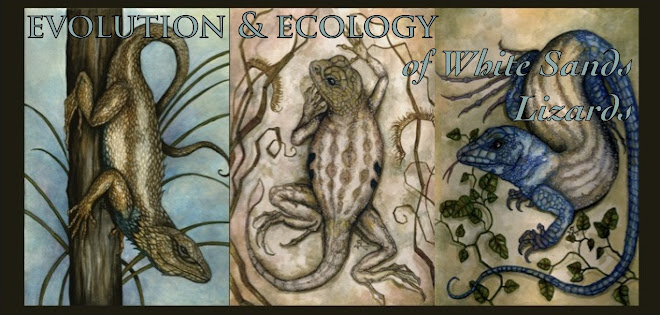Well, it is about time I spoke a bit about our adventures putting on our outreach program last week. On Thursday and Friday we led a "Lizards of the White Sands" day camp for local kids ages seven to fourteen as part of the White Sands Institute (which is an organisation that runs various classes for the public to enjoy the national monument).
This year is our second year running the event so fortunately we had a working schedule:
I. Introduction to White Sands, lizard ecology, and evolution.
II. Pack up with lots of water, sunscreen, and sunglasses to go out to the dunes.
 |
| Isaiah, Mikki, and I before the Natural Selection Game. |
I divided the group of kids into 1/3 Roadrunners, or "Predators," and 2/3 Lizards, or "Prey." (on the first day, we had 21 kids - 7 predators, 14 prey; on the second day, we had 12 kids - 4 predators, 8 prey... much more manageable)...
 |
| Before the game. |
 |
| Explaining the rules. |
 |
| Ready to let the kids loose for the game. |
 |
| Go Roadrunner-Kids! |
 |
| Setting out lizard models. |
 |
| Laying out the day's catch. |
 |
| Explaining natural selection. |
What were the lizards doing when you first spotted them? What is the shape and colour of each species? How do you tell a male from a female?
 |
| Kayla showing her troop a little striped whiptail. |
The three funniest comments from the two days? (embarrassingly two came from my mouth):
3. (during my introduction talk) Me: "White Sands is very very young compared to the age of the Earth... it is only about 6,000 years old."; Kid: "So it's like a baby?"; Me: "Yes, White Sands is a geological baby"
2. (after drawing a horned lizard on a sheet of paper) Kid: "How big are those lizards?"; Me: "Oh about the size of your fist"; Kid: "So... like the size of a hairball... like a cat's hairball?"; Me: "Uh, sure..."
 |
| Participants showing off their lizard mugs. |
As usual we had a fantastic time with the kids- definitely one of my highlights of the summer. We are certainly fortunate to work in White Sands where we have the opportunity to put on such outreach programs! Thank you to my assistants, Isaiah, Mikki, and Jackie for helping me out this year, to David Bustos and Joan Griggs for doing the logistical work and advertising to get the camp running, and finally to my advisor Bree for letting us take charge and providing the foundation for the program!
-S. Des Roches









